transmission FIAT DOBLO COMBI 2018 Owner handbook (in English)
[x] Cancel search | Manufacturer: FIAT, Model Year: 2018, Model line: DOBLO COMBI, Model: FIAT DOBLO COMBI 2018Pages: 272, PDF Size: 23.75 MB
Page 145 of 272
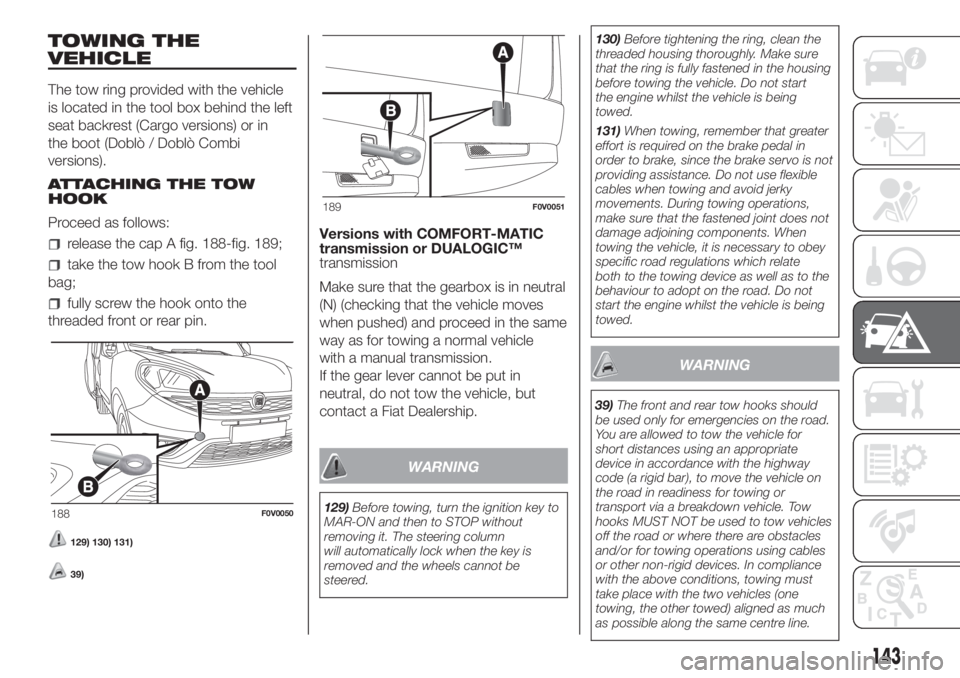
TOWING THE
VEHICLE
The tow ring provided with the vehicle
is located in the tool box behind the left
seat backrest (Cargo versions) or in
the boot (Doblò / Doblò Combi
versions).
ATTACHING THE TOW
HOOK
Proceed as follows:
release the cap A fig. 188-fig. 189;
take the tow hook B from the tool
bag;
fully screw the hook onto the
threaded front or rear pin.
129) 130) 131)
39)
Versions with COMFORT-MATIC
transmission or DUALOGIC™
transmission
Make sure that the gearbox is in neutral
(N) (checking that the vehicle moves
when pushed) and proceed in the same
way as for towing a normal vehicle
with a manual transmission.
If the gear lever cannot be put in
neutral, do not tow the vehicle, but
contact a Fiat Dealership.
WARNING
129)Before towing, turn the ignition key to
MAR-ON and then to STOP without
removing it. The steering column
will automatically lock when the key is
removed and the wheels cannot be
steered.130)Before tightening the ring, clean the
threaded housing thoroughly. Make sure
that the ring is fully fastened in the housing
before towing the vehicle. Do not start
the engine whilst the vehicle is being
towed.
131)When towing, remember that greater
effort is required on the brake pedal in
order to brake, since the brake servo is not
providing assistance. Do not use flexible
cables when towing and avoid jerky
movements. During towing operations,
make sure that the fastened joint does not
damage adjoining components. When
towing the vehicle, it is necessary to obey
specific road regulations which relate
both to the towing device as well as to the
behaviour to adopt on the road. Do not
start the engine whilst the vehicle is being
towed.
WARNING
39)The front and rear tow hooks should
be used only for emergencies on the road.
You are allowed to tow the vehicle for
short distances using an appropriate
device in accordance with the highway
code (a rigid bar), to move the vehicle on
the road in readiness for towing or
transport via a breakdown vehicle. Tow
hooks MUST NOT be used to tow vehicles
off the road or where there are obstacles
and/or for towing operations using cables
or other non-rigid devices. In compliance
with the above conditions, towing must
take place with the two vehicles (one
towing, the other towed) aligned as much
as possible along the same centre line.
188F0V0050
189F0V0051
143
Page 153 of 272

DIESEL VERSIONS WITH DPF (1.3 MultiJet - 1.6 MultiJet - 2.0 MultiJet)
IMPORTANT Once you have carried out the last intervention in the table, continue with the scheduled servicing, maintaining the
frequency indicated in the plan by marking each operation with a dot or dedicated note. Warning: simply restarting the
maintenance from the start of the plan may cause the allowed interval to be exceeded for some operations!
151
Thousands of miles 21 42 63 84 105
Thousands of kilometres 35 70 105 140 175
Years246810
Check battery charge status and possibly recharge●●●●●
Check tyre condition/wear and adjust pressure, if necessary;
check the condition/expiry date of the “Fix&Go Automatic” repair
kit (for versions/markets, where provided)●●●●●
Check operation of lighting system (headlamps, direction
indicators, hazard warning lights, luggage compartment,
passenger compartment, glove compartment, instrument panel
warning lights, etc.)●●●●●
Check and, if necessary, top up fluid levels (1)●●●●●
Check and top up transmission oil level (1.6 Multijet 90 HP with
Comfort-matic andDualogic™transmission)●●●●●
Check exhaust emissions●●●●●
Use the diagnosis socket to check supply/engine management
system operation, emissions and, for versions/markets, where
provided, engine oil degradation●●●●●
(1) Always only use the liquids shown in the handbook for topping up after having checked that the system is not damaged.
Page 154 of 272
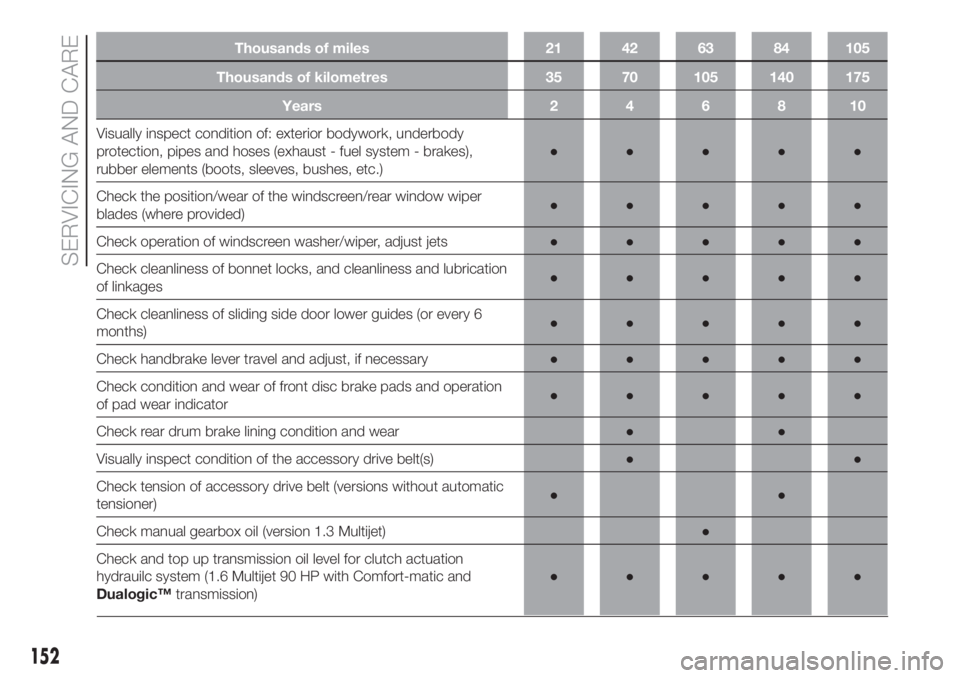
152
SERVICING AND CARE
Thousands of miles 21 42 63 84 105
Thousands of kilometres 35 70 105 140 175
Years246810
Visually inspect condition of: exterior bodywork, underbody
protection, pipes and hoses (exhaust - fuel system - brakes),
rubber elements (boots, sleeves, bushes, etc.)●●●●●
Check the position/wear of the windscreen/rear window wiper
blades (where provided)●●●●●
Check operation of windscreen washer/wiper, adjust jets●●●●●
Check cleanliness of bonnet locks, and cleanliness and lubrication
of linkages●●●●●
Check cleanliness of sliding side door lower guides (or every 6
months)●●●●●
Check handbrake lever travel and adjust, if necessary●●●●●
Check condition and wear of front disc brake pads and operation
of pad wear indicator●●●●●
Check rear drum brake lining condition and wear●●
Visually inspect condition of the accessory drive belt(s)●●
Check tension of accessory drive belt (versions without automatic
tensioner)●●
Check manual gearbox oil (version 1.3 Multijet)●
Check and top up transmission oil level for clutch actuation
hydrauilc system (1.6 Multijet 90 HP with Comfort-matic and
Dualogic™transmission)●●●●●
Page 155 of 272
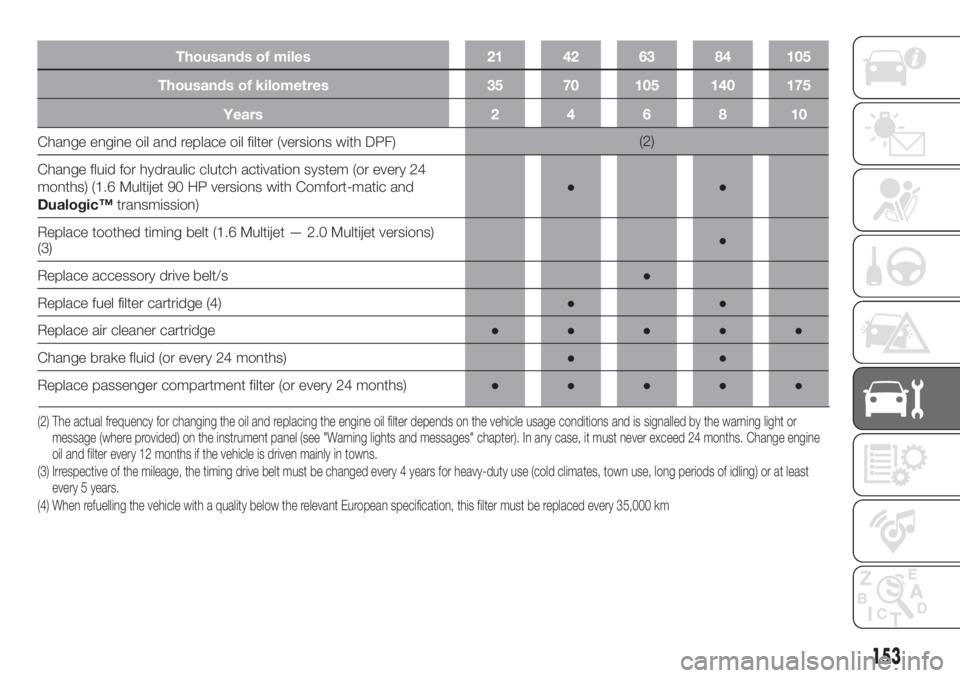
153
Thousands of miles 21 42 63 84 105
Thousands of kilometres 35 70 105 140 175
Years246810
Change engine oil and replace oil filter (versions with DPF)(2)
Change fluid for hydraulic clutch activation system (or every 24
months) (1.6 Multijet 90 HP versions with Comfort-matic and
Dualogic™transmission)●●
Replace toothed timing belt (1.6 Multijet — 2.0 Multijet versions)
(3)●
Replace accessory drive belt/s●
Replace fuel filter cartridge (4)●●
Replace air cleaner cartridge●●●●●
Change brake fluid (or every 24 months)●●
Replace passenger compartment filter (or every 24 months)●●●●●
(2) The actual frequency for changing the oil and replacing the engine oil filter depends on the vehicle usage conditions and is signalled by the warning light or
message (where provided) on the instrument panel (see "Warning lights and messages" chapter). In any case, it must never exceed 24 months. Change engine
oil and filter every 12 months if the vehicle is driven mainly in towns.
(3) Irrespective of the mileage, the timing drive belt must be changed every 4 years for heavy-duty use (cold climates, town use, long periods of idling) or at least
every 5 years.
(4) When refuelling the vehicle with a quality below the relevant European specification, this filter must be replaced every 35,000 km
Page 156 of 272
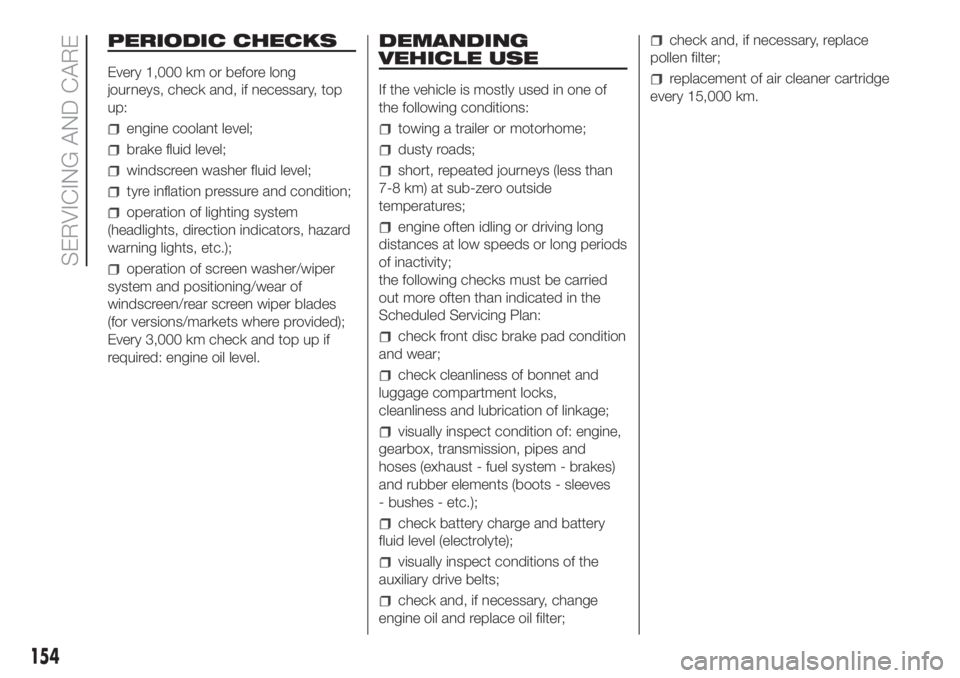
PERIODIC CHECKS
Every 1,000 km or before long
journeys, check and, if necessary, top
up:
engine coolant level;
brake fluid level;
windscreen washer fluid level;
tyre inflation pressure and condition;
operation of lighting system
(headlights, direction indicators, hazard
warning lights, etc.);
operation of screen washer/wiper
system and positioning/wear of
windscreen/rear screen wiper blades
(for versions/markets where provided);
Every 3,000 km check and top up if
required: engine oil level.
DEMANDING
VEHICLE USE
If the vehicle is mostly used in one of
the following conditions:
towing a trailer or motorhome;
dusty roads;
short, repeated journeys (less than
7-8 km) at sub-zero outside
temperatures;
engine often idling or driving long
distances at low speeds or long periods
of inactivity;
the following checks must be carried
out more often than indicated in the
Scheduled Servicing Plan:
check front disc brake pad condition
and wear;
check cleanliness of bonnet and
luggage compartment locks,
cleanliness and lubrication of linkage;
visually inspect condition of: engine,
gearbox, transmission, pipes and
hoses (exhaust - fuel system - brakes)
and rubber elements (boots - sleeves
- bushes - etc.);
check battery charge and battery
fluid level (electrolyte);
visually inspect conditions of the
auxiliary drive belts;
check and, if necessary, change
engine oil and replace oil filter;
check and, if necessary, replace
pollen filter;
replacement of air cleaner cartridge
every 15,000 km.
154
SERVICING AND CARE
Page 167 of 272
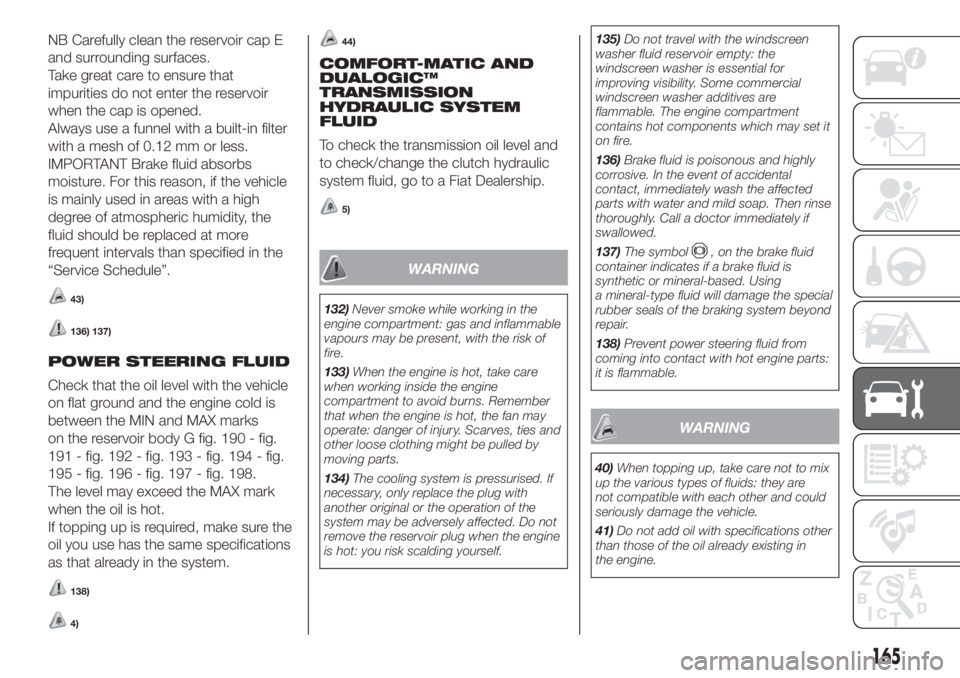
NB Carefully clean the reservoir cap E
and surrounding surfaces.
Take great care to ensure that
impurities do not enter the reservoir
when the cap is opened.
Always use a funnel with a built-in filter
with a mesh of 0.12 mm or less.
IMPORTANT Brake fluid absorbs
moisture. For this reason, if the vehicle
is mainly used in areas with a high
degree of atmospheric humidity, the
fluid should be replaced at more
frequent intervals than specified in the
“Service Schedule”.
43)
136) 137)
POWER STEERING FLUID
Check that the oil level with the vehicle
on flat ground and the engine cold is
between the MIN and MAX marks
on the reservoir body G fig. 190 - fig.
191 - fig. 192 - fig. 193 - fig. 194 - fig.
195 - fig. 196 - fig. 197 - fig. 198.
The level may exceed the MAX mark
when the oil is hot.
If topping up is required, make sure the
oil you use has the same specifications
as that already in the system.
138)
4)
44)
COMFORT-MATIC AND
DUALOGIC™
TRANSMISSION
HYDRAULIC SYSTEM
FLUID
To check the transmission oil level and
to check/change the clutch hydraulic
system fluid, go to a Fiat Dealership.
5)
WARNING
132)Never smoke while working in the
engine compartment: gas and inflammable
vapours may be present, with the risk of
fire.
133)When the engine is hot, take care
when working inside the engine
compartment to avoid burns. Remember
that when the engine is hot, the fan may
operate: danger of injury. Scarves, ties and
other loose clothing might be pulled by
moving parts.
134)The cooling system is pressurised. If
necessary, only replace the plug with
another original or the operation of the
system may be adversely affected. Do not
remove the reservoir plug when the engine
is hot: you risk scalding yourself.135)Do not travel with the windscreen
washer fluid reservoir empty: the
windscreen washer is essential for
improving visibility. Some commercial
windscreen washer additives are
flammable. The engine compartment
contains hot components which may set it
on fire.
136)Brake fluid is poisonous and highly
corrosive. In the event of accidental
contact, immediately wash the affected
parts with water and mild soap. Then rinse
thoroughly. Call a doctor immediately if
swallowed.
137)The symbol
, on the brake fluid
container indicates if a brake fluid is
synthetic or mineralbased. Using
a mineral-type fluid will damage the special
rubber seals of the braking system beyond
repair.
138)Prevent power steering fluid from
coming into contact with hot engine parts:
it is flammable.
WARNING
40)When topping up, take care not to mix
up the various types of fluids: they are
not compatible with each other and could
seriously damage the vehicle.
41)Do not add oil with specifications other
than those of the oil already existing in
the engine.
165
Page 168 of 272
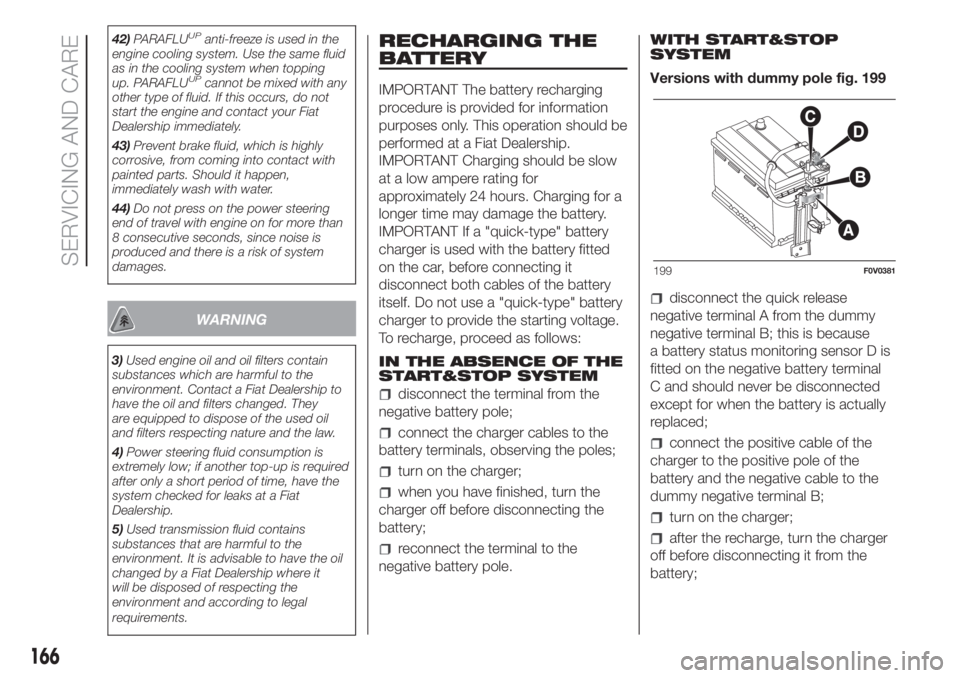
42)PARAFLUUPanti-freeze is used in the
engine cooling system. Use the same fluid
as in the cooling system when topping
up. PARAFLU
UPcannot be mixed with any
other type of fluid. If this occurs, do not
start the engine and contact your Fiat
Dealership immediately.
43)Prevent brake fluid, which is highly
corrosive, from coming into contact with
painted parts. Should it happen,
immediately wash with water.
44)Do not press on the power steering
end of travel with engine on for more than
8 consecutive seconds, since noise is
produced and there is a risk of system
damages.
WARNING
3)Used engine oil and oil filters contain
substances which are harmful to the
environment. Contact a Fiat Dealership to
have the oil and filters changed. They
are equipped to dispose of the used oil
and filters respecting nature and the law.
4)Power steering fluid consumption is
extremely low; if another top-up is required
after only a short period of time, have the
system checked for leaks at a Fiat
Dealership.
5)Used transmission fluid contains
substances that are harmful to the
environment. It is advisable to have the oil
changed by a Fiat Dealership where it
will be disposed of respecting the
environment and according to legal
requirements.
RECHARGING THE
BATTERY
IMPORTANT The battery recharging
procedure is provided for information
purposes only. This operation should be
performed at a Fiat Dealership.
IMPORTANT Charging should be slow
at a low ampere rating for
approximately 24 hours. Charging for a
longer time may damage the battery.
IMPORTANT If a "quick-type" battery
charger is used with the battery fitted
on the car, before connecting it
disconnect both cables of the battery
itself. Do not use a "quick-type" battery
charger to provide the starting voltage.
To recharge, proceed as follows:
IN THE ABSENCE OF THE
START&STOP SYSTEM
disconnect the terminal from the
negative battery pole;
connect the charger cables to the
battery terminals, observing the poles;
turn on the charger;
when you have finished, turn the
charger off before disconnecting the
battery;
reconnect the terminal to the
negative battery pole.WITH START&STOP
SYSTEM
Versions with dummy pole fig. 199
disconnect the quick release
negative terminal A from the dummy
negative terminal B; this is because
a battery status monitoring sensor D is
fitted on the negative battery terminal
C and should never be disconnected
except for when the battery is actually
replaced;
connect the positive cable of the
charger to the positive pole of the
battery and the negative cable to the
dummy negative terminal B;
turn on the charger;
after the recharge, turn the charger
off before disconnecting it from the
battery;
199F0V0381
166
SERVICING AND CARE
Page 193 of 272
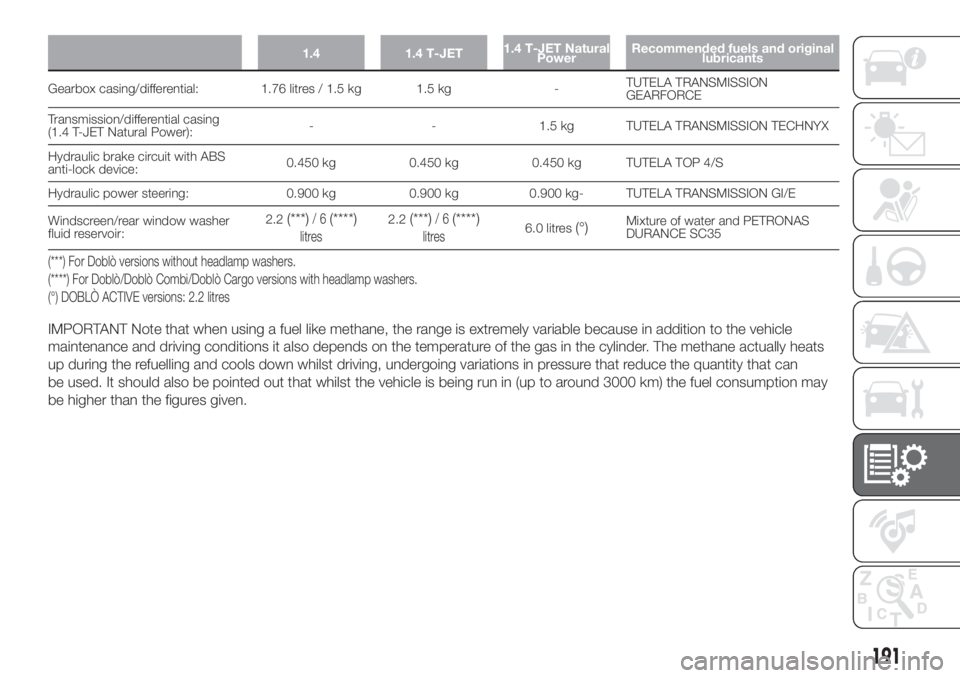
1.4 1.4 T-JET1.4 T-JET Natural
PowerRecommended fuels and original
lubricants
Gearbox casing/differential: 1.76 litres / 1.5 kg 1.5 kg -TUTELA TRANSMISSION
GEARFORCE
Transmission/differential casing
(1.4 T-JET Natural Power):- - 1.5 kg TUTELA TRANSMISSION TECHNYX
Hydraulic brake circuit with ABS
anti-lock device:0.450 kg 0.450 kg 0.450 kg TUTELA TOP 4/S
Hydraulic power steering: 0.900 kg 0.900 kg 0.900 kg- TUTELA TRANSMISSION GI/E
Windscreen/rear window washer
fluid reservoir:2.2
(***)/6(****)
litres
2.2(***)/6(****)
litres6.0 litres(°)Mixture of water and PETRONAS
DURANCE SC35
(***) For Doblò versions without headlamp washers.
(****) For Doblò/Doblò Combi/Doblò Cargo versions with headlamp washers.
(°) DOBLÒ ACTIVE versions: 2.2 litres
IMPORTANT Note that when using a fuel like methane, the range is extremely variable because in addition to the vehicle
maintenance and driving conditions it also depends on the temperature of the gas in the cylinder. The methane actually heats
up during the refuelling and cools down whilst driving, undergoing variations in pressure that reduce the quantity that can
be used. It should also be pointed out that whilst the vehicle is being run in (up to around 3000 km) the fuel consumption may
be higher than the figures given.
191
Page 194 of 272
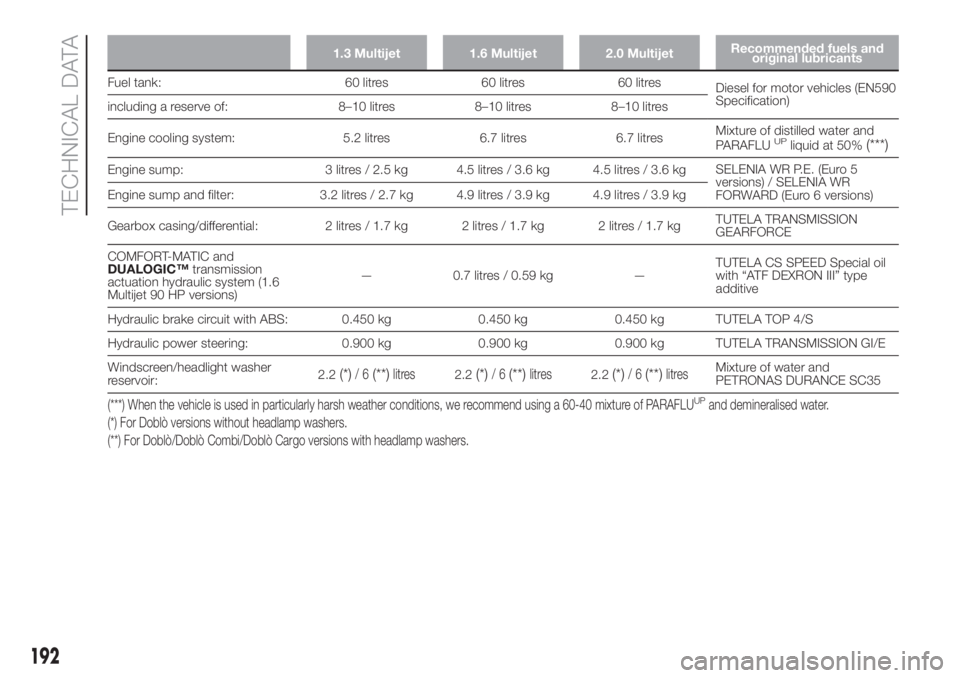
1.3 Multijet 1.6 Multijet 2.0 MultijetRecommended fuels and
original lubricants
Fuel tank: 60 litres 60 litres 60 litres
Diesel for motor vehicles (EN590
Specification)
including a reserve of: 8–10 litres 8–10 litres 8–10 litres
Engine cooling system: 5.2 litres 6.7 litres 6.7 litresMixture of distilled water and
PARAFLU
UPliquid at 50%(***)
Engine sump: 3 litres / 2.5 kg 4.5 litres / 3.6 kg 4.5 litres / 3.6 kgSELENIA WR P.E. (Euro 5
versions) / SELENIA WR
FORWARD (Euro 6 versions) Engine sump and filter: 3.2 litres / 2.7 kg 4.9 litres / 3.9 kg 4.9 litres / 3.9 kg
Gearbox casing/differential: 2 litres / 1.7 kg 2 litres / 1.7 kg 2 litres / 1.7 kgTUTELA TRANSMISSION
GEARFORCE
COMFORT-MATIC and
DUALOGIC™transmission
actuation hydraulic system (1.6
Multijet 90 HP versions)— 0.7 litres / 0.59 kg —TUTELA CS SPEED Special oil
with “ATF DEXRON III” type
additive
Hydraulic brake circuit with ABS: 0.450 kg 0.450 kg 0.450 kg TUTELA TOP 4/S
Hydraulic power steering: 0.900 kg 0.900 kg 0.900 kg TUTELA TRANSMISSION GI/E
Windscreen/headlight washer
reservoir:2.2
(*)/6(**)litres2.2(*)/6(**)litres2.2(*)/6(**)litresMixture of water and
PETRONAS DURANCE SC35
(***) When the vehicle is used in particularly harsh weather conditions, we recommend using a 60-40 mixture of PARAFLUUPand demineralised water.
(*) For Doblò versions without headlamp washers.
(**) For Doblò/Doblò Combi/Doblò Cargo versions with headlamp washers.
192
TECHNICAL DATA
Page 196 of 272
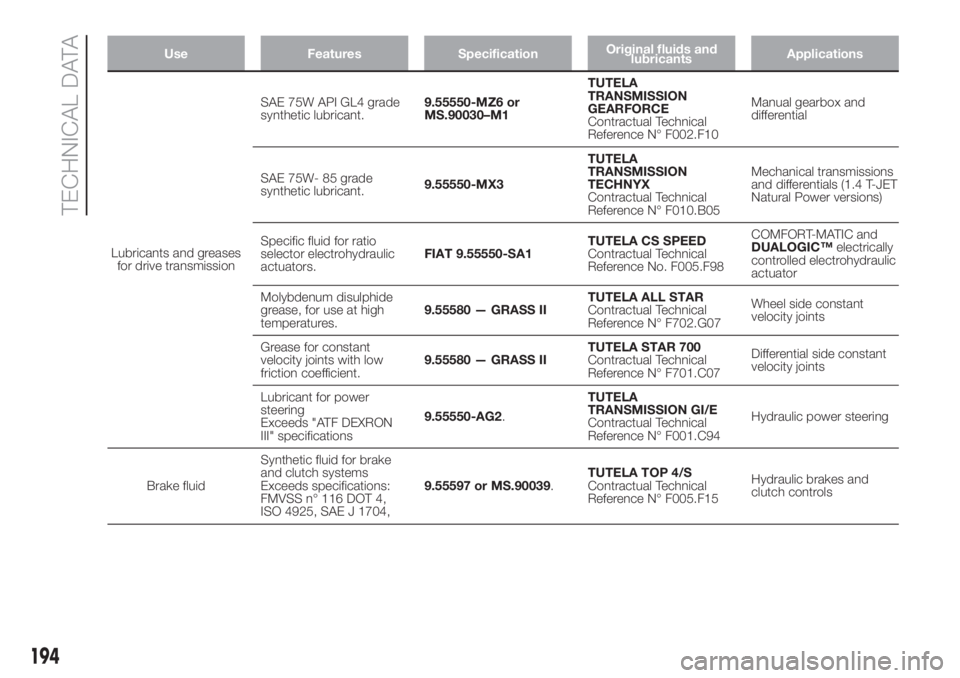
Use Features SpecificationOriginal fluids and
lubricantsApplications
Lubricants and greases
for drive transmissionSAE 75W API GL4 grade
synthetic lubricant.9.55550-MZ6 or
MS.90030–M1TUTELA
TRANSMISSION
GEARFORCE
Contractual Technical
Reference N° F002.F10Manual gearbox and
differential
SAE 75W- 85 grade
synthetic lubricant.9.55550-MX3TUTELA
TRANSMISSION
TECHNYX
Contractual Technical
Reference N° F010.B05Mechanical transmissions
and differentials (1.4 T-JET
Natural Power versions)
Specific fluid for ratio
selector electrohydraulic
actuators.FIAT 9.55550-SA1TUTELA CS SPEED
Contractual Technical
Reference No. F005.F98COMFORT-MATIC and
DUALOGIC™electrically
controlled electrohydraulic
actuator
Molybdenum disulphide
grease, for use at high
temperatures.9.55580 — GRASS IITUTELA ALL STAR
Contractual Technical
Reference N° F702.G07Wheel side constant
velocity joints
Grease for constant
velocity joints with low
friction coefficient.9.55580 — GRASS IITUTELA STAR 700
Contractual Technical
Reference N° F701.C07Differential side constant
velocity joints
Lubricant for power
steering
Exceeds "ATF DEXRON
III" specifications9.55550-AG2.TUTELA
TRANSMISSION GI/E
Contractual Technical
Reference N° F001.C94Hydraulic power steering
Brake fluidSynthetic fluid for brake
and clutch systems
Exceeds specifications:
FMVSS n° 116 DOT 4,
ISO 4925, SAE J 1704,9.55597 or MS.90039.TUTELA TOP 4/S
Contractual Technical
Reference N° F005.F15Hydraulic brakes and
clutch controls
194
TECHNICAL DATA